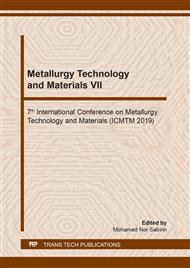[1]
O. A. OLUFAYO, ULTRA-HIGH PRECISION MANUFACTURING OF CONTACT LENS POLYMERS,, PhD Thesis, Mechatronics Engineering, Faculty of Engineering, the Built Environment and Information Technology, Nelson Mandela Metropolitan University, (2015).
Google Scholar
[2]
L. Bouzid, S. Boutabba, M. A. Yallese, S. Belhadi, and F. Girardin, Simultaneous optimization of surface roughness and material removal rate for turning of X20Cr13 stainless steel,, The International Journal of Advanced Manufacturing Technology, vol. 74, pp.879-891, (2014).
DOI: 10.1007/s00170-014-6043-9
Google Scholar
[3]
M. M. Liman and K. Abou-El-Hossein, Modeling and multiresponse optimization of cutting parameters in SPDT of a rigid contact lens polymer using RSM and desirability function,, The International Journal of Advanced Manufacturing Technology, pp.1-23, (2019).
DOI: 10.1007/s00170-018-3169-1
Google Scholar
[4]
G. P. H. Gubbels, Diamond turning of glassy polymers,, vol. 68, ed: Citeseer, (2006).
Google Scholar
[5]
J. Oomen and J. Eisses, Wear of monocrystalline diamond tools during ultraprecision machining of nonferrous metals,, Precision Engineering, vol. 14, pp.206-218, (1992).
DOI: 10.1016/0141-6359(92)90018-r
Google Scholar
[6]
C. F. Tooling, Diamond Tool wear during cutting of plastics,, (2008).
Google Scholar
[7]
M. M. Liman, DIAMOND TURNING OF CONTACT LENS POLYMERS,, Masters of Engineering, Mechatronics Engineering, Nelson Mandela Metropolitan University, (2017).
Google Scholar
[8]
O. Olufayo, K. Abou-El-Hossein, and M. Kadernani, Tribo-electric charging in the ultra-high precision machining of contact lens polymers,, Procedia Materials Science, vol. 6, pp.194-201, (2014).
DOI: 10.1016/j.mspro.2014.07.024
Google Scholar
[9]
G. Gubbels, G. Van Der Beek, F. Delbressine, and P. Schellekens, Electrostatic tool wear in diamond turning of amorphous polymers,, in 4th euspen International Conference, Glasgow, Scotland, UK, (2004).
DOI: 10.1016/s0007-8506(07)60736-7
Google Scholar
[10]
M. M. Liman, K. Abou-El-Hossein, and P. B. Odedeyi, Modeling and Prediction of Surface Roughness in Ultra-High Precision Diamond Turning of Contact Lens Polymer Using RSM and ANN Methods,, in Materials Science Forum, 2018, pp.139-143.
DOI: 10.4028/www.scientific.net/msf.928.139
Google Scholar
[11]
A. Chabbi, M. A. Yallese, I. Meddour, M. Nouioua, T. Mabrouki, and F. Girardin, Predictive modeling and multi-response optimization of technological parameters in turning of Polyoxymethylene polymer (POM C) using RSM and desirability function,, Measurement, vol. 95, pp.99-115, (2017).
DOI: 10.1016/j.measurement.2016.09.043
Google Scholar
[12]
M. M. Liman, K. Abou-El-Hossein, A. I. Jumare, P. B. Odedeyi, and A. N. Lukman, Modelling of surface roughness in ultra-high precision turning of an RGP contact lens polymer,, in Key Engineering Materials, 2017, pp.183-187.
DOI: 10.4028/www.scientific.net/kem.753.183
Google Scholar


